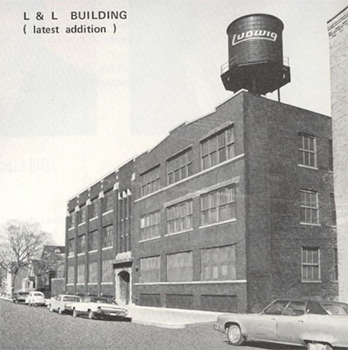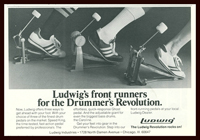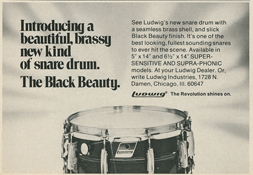

The 1970’s marked the start of a new journey for Ludwig and presented yet another production boom. The company embarked upon the 1970’s with a new company president, William Ludwig II. Successor to his father, William the II was determined to keep Ludwig a prominent figure in the music industry. Just as in the decade prior, Ludwig production kept onward focusing on fresh innovative ideas. Production for Ludwig excelled beyond what the facility at 1728 N. Damen could accommodate, requiring the expansion of their production facility. Ludwig drums would produce and manufacture almost every aspect that went into completing a drum.

Ludwig would seek out the addition of another building to keep up with the manufacturing of their expanded catalog. That lead to reacquiring the old Ludwig and Ludwig building in Chicago located at 1611 N. Wolcott. Production spaces for their expanded drum and hardware catalog could now be accommodated to. Ludwig would be quick and concentrated to the drawing board, focusing on volume and durability as elements surrounding new designs as drumming took a new turn with the evolution of rock in to a roaring thunderous sound sensation. Drummers sought out tougher, louder, and sturdier gear. Music genres evolved greatly in the 1970’s. Many new sounds took to the stage and Ludwig drums were right there for the ride, influencing the sound and look of the 1970’s.

Classic shell layout began to change in construction, design, and appearance. This era brought new shell concepts and outfits that included the Vistalite Series, Stainless Steel Series, and concert tom Aerial drums. Along with these new shell concepts, Ludwig would revamp and redesigned various existing wood shell kits: Mach Series, expanded Classic outfits, Club Date, Standard, and Jazzette. The Atlas hardware line was also introduced, an evolved drum hardware line from the thin flat base stand design to a thicker sturdier tripod design. Shell hardware from the 1970’s also went through progressive changes, like that witnessed of the 1960's. These new designs were just a few that would characterize the development of the Ludwig Co. from the 1960’s to the 1970’s.

Ludwig definitely raised the bar in the 1970’s. They were successful in redefining drums by presenting products unfathomed by any existing drum company. This era was rather unique for Ludwig. It could be characterized as an era of much success, as well having presented its fair share of unprofitable concepts. However, failed concepts could be easily argued to have been ahead of its time. Ludwig would produce highly coveted products in today’s market. Not only did they take chances redefining their typical catalog, Ludwig would make its attempt into the guitar industry by producing its very effects pedal unit. Ludwig innovation would be as fresh and unique as pop culture of the 1970’s.

 The 1970’s marked the start of a new journey for Ludwig and presented yet another production boom. The company embarked upon the 1970’s with a new company president, William Ludwig II. Successor to his father, William the II was determined to keep Ludwig a prominent figure in the music industry. Just as in the decade prior, Ludwig production kept onward focusing on fresh innovative ideas. Production for Ludwig excelled beyond what the facility at 1728 N. Damen could accommodate, requiring the expansion of their production facility. Ludwig drums would produce and manufacture almost every aspect that went into completing a drum.
The 1970’s marked the start of a new journey for Ludwig and presented yet another production boom. The company embarked upon the 1970’s with a new company president, William Ludwig II. Successor to his father, William the II was determined to keep Ludwig a prominent figure in the music industry. Just as in the decade prior, Ludwig production kept onward focusing on fresh innovative ideas. Production for Ludwig excelled beyond what the facility at 1728 N. Damen could accommodate, requiring the expansion of their production facility. Ludwig drums would produce and manufacture almost every aspect that went into completing a drum.  Ludwig would seek out the addition of another building to keep up with the manufacturing of their expanded catalog. That lead to reacquiring the old Ludwig and Ludwig building in Chicago located at 1611 N. Wolcott. Production spaces for their expanded drum and hardware catalog could now be accommodated to. Ludwig would be quick and concentrated to the drawing board, focusing on volume and durability as elements surrounding new designs as drumming took a new turn with the evolution of rock in to a roaring thunderous sound sensation. Drummers sought out tougher, louder, and sturdier gear. Music genres evolved greatly in the 1970’s. Many new sounds took to the stage and Ludwig drums were right there for the ride, influencing the sound and look of the 1970’s.
Ludwig would seek out the addition of another building to keep up with the manufacturing of their expanded catalog. That lead to reacquiring the old Ludwig and Ludwig building in Chicago located at 1611 N. Wolcott. Production spaces for their expanded drum and hardware catalog could now be accommodated to. Ludwig would be quick and concentrated to the drawing board, focusing on volume and durability as elements surrounding new designs as drumming took a new turn with the evolution of rock in to a roaring thunderous sound sensation. Drummers sought out tougher, louder, and sturdier gear. Music genres evolved greatly in the 1970’s. Many new sounds took to the stage and Ludwig drums were right there for the ride, influencing the sound and look of the 1970’s.  Classic shell layout began to change in construction, design, and appearance. This era brought new shell concepts and outfits that included the Vistalite Series, Stainless Steel Series, and concert tom Aerial drums. Along with these new shell concepts, Ludwig would revamp and redesigned various existing wood shell kits: Mach Series, expanded Classic outfits, Club Date, Standard, and Jazzette. The Atlas hardware line was also introduced, an evolved drum hardware line from the thin flat base stand design to a thicker sturdier tripod design. Shell hardware from the 1970’s also went through progressive changes, like that witnessed of the 1960's. These new designs were just a few that would characterize the development of the Ludwig Co. from the 1960’s to the 1970’s.
Classic shell layout began to change in construction, design, and appearance. This era brought new shell concepts and outfits that included the Vistalite Series, Stainless Steel Series, and concert tom Aerial drums. Along with these new shell concepts, Ludwig would revamp and redesigned various existing wood shell kits: Mach Series, expanded Classic outfits, Club Date, Standard, and Jazzette. The Atlas hardware line was also introduced, an evolved drum hardware line from the thin flat base stand design to a thicker sturdier tripod design. Shell hardware from the 1970’s also went through progressive changes, like that witnessed of the 1960's. These new designs were just a few that would characterize the development of the Ludwig Co. from the 1960’s to the 1970’s. Ludwig definitely raised the bar in the 1970’s. They were successful in redefining drums by presenting products unfathomed by any existing drum company. This era was rather unique for Ludwig. It could be characterized as an era of much success, as well having presented its fair share of unprofitable concepts. However, failed concepts could be easily argued to have been ahead of its time. Ludwig would produce highly coveted products in today’s market. Not only did they take chances redefining their typical catalog, Ludwig would make its attempt into the guitar industry by producing its very effects pedal unit. Ludwig innovation would be as fresh and unique as pop culture of the 1970’s.
Ludwig definitely raised the bar in the 1970’s. They were successful in redefining drums by presenting products unfathomed by any existing drum company. This era was rather unique for Ludwig. It could be characterized as an era of much success, as well having presented its fair share of unprofitable concepts. However, failed concepts could be easily argued to have been ahead of its time. Ludwig would produce highly coveted products in today’s market. Not only did they take chances redefining their typical catalog, Ludwig would make its attempt into the guitar industry by producing its very effects pedal unit. Ludwig innovation would be as fresh and unique as pop culture of the 1970’s.